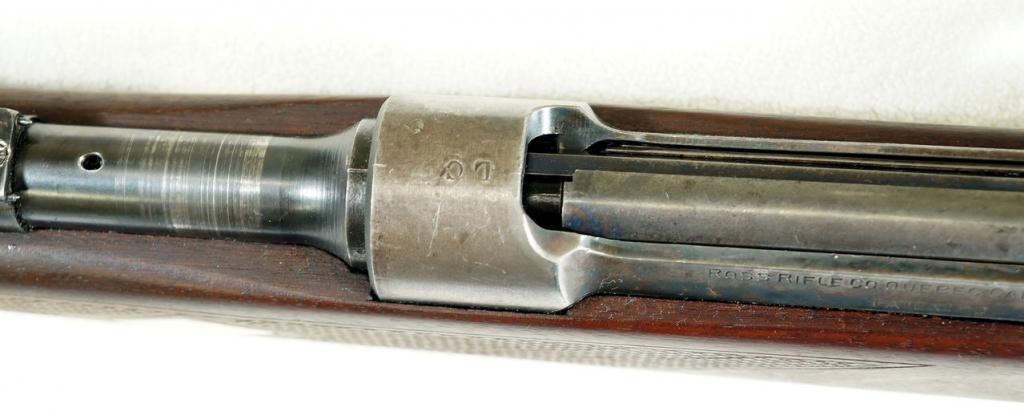-
FREE MEMBER
NO Posting or PM's Allowed

Ross 1905 barrel set-back
Question for you guys...I found a 1905 Ross in a local shop that I am considering buying - it hasn't had the barrel or stock cut down, and the stock is marked up with unit numbers. However, the barrel appears to have been cut back by about an inch at the chamber. The stock is clearly cut to have the barrel profile farther forward than it currently is, and there is a visible hole drilled into the top (but not clear through) of barrel in between the receiver and rear sight (the handguard does not cover that area). The rear sight also has two little prods pointing rearward, which would seem to be intended to secure a part of the handguard.
I didn't have a camera with me to take a photo, but I found an example of one similar:

This photo show a stock that fits the barrel contour - the rifle I found has the barrel profile and placement the same (and the same rear end of the rear sight and the sale hole atop the barrel) but the stock is clearly intended to have the barrel an inch longer before its diameter reduces (and the rifle I found does not have the LC marking).
I hope this makes some sense - can anyone explain what has been done to this rifle, who did it, and whether it would be safe to shoot?
Thanks!
Information
 |
Warning: This is a relatively older thread
This discussion is older than 360 days. Some information contained in it may no longer be current. |
|
-
09-16-2014 04:25 PM
# ADS
Friends and Sponsors

-
Contributing Member


The US gov't shortened som MkII 3* rifles that were purchased by the US as WWI training rifles. The shortened tge breech end by 7/8" to alleviate a headspace issue. The holes on the bittom of the barrel are the former location of the two holes for the rear sight base and the barrels indexed 180* from original after they were shortened. There are photos in TRRS of US bayonets that were modified for use with these shortened rifles. I have an example of one of these at home, although it is only a barrelled action.
-
-
-
Advisory Panel



Originally Posted by
ForgottenWeapons

(and the rifle I found does not have the LC marking).
Is that an LC or a DC, as in DCRA? What would it be for? Anyone know?
-
-
Advisory Panel


Is that an LC or a DC, as in DCRA? What would it be for? Anyone know?
Looks like "LC"; presumably "Large Cone" as per recent discussion in another thread.
Bolt's not fully closed in the photo; sticky?
“There are invisible rulers who control the destinies of millions. It is not generally realized to what extent the words and actions of our most influential public men are dictated by shrewd persons operating behind the scenes.”
Edward Bernays, 1928
Much changes, much remains the same. 
-
The Following 2 Members Say Thank You to Surpmil For This Useful Post:
-
Advisory Panel


Long Chamber (LC) was first to lengthen chamber for WWI ammunition variations. Later gun was converted to indoor winter shooting range training rifle firing short case ammunition with round led ball. Service ammunition would not chamber. If yours takes service length cartridges, it was altered by surplus dealers long ago to sell product. Note with all these changes, the chamber walls are very thin to the point it is not advisable to fire service cartridges. My two cents to get in before someone says they have been shooting xxx in them for years.
-
Thank You to breakeyp For This Useful Post:
-
Contributing Member


With pictures it is obvious what breakeyp is referring to. First picture, remove the barrel retaining screw. Second picture, inside the receiver view of the barrel retaining screw and the what it butts against on the barrel. And finally, the very fast left hand (turn clockwise to remove) three threads per inch of this MkII. If someone cut the original threads off (about 3/4"), possibly to re-thread to a more normal thread pitch, then re-threaded and re chambered the barrel to full sized service ammunition, it doesn't appear it would leave enough metal in the chamber area for safety. Tom
-
-
Advisory Panel


I had forgotten they came off like that.
-
















 Register To Reply
Register To Reply












